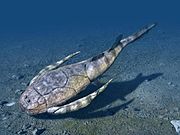| Saimiri annectens | |
|---|---|
| Scientific classification | |
| Domain: | Eukaryota |
| Kingdom: | Animalia |
| Phylum: | Chordata |
| Class: | Mammalia |
| Order: | Primates |
| Suborder: | Haplorhini |
| Infraorder: | Simiiformes |
| Family: | Cebidae |
| Genus: | Saimiri |
| Species: | †S. annectens
|
| Binomial name | |
| †Saimiri annectens Kay & Meldrum 1997
| |
| Synonyms | |
| |
Saimiri annectens, originally described as Laventiana annectens and later as Neosaimiri annectens, is an extinct species of New World monkey in the genus Saimiri (squirrel monkeys) from the Middle Miocene (Laventan in the South American land mammal ages; 13.8 to 11.8 Ma). Its remains have been found at the Konzentrat-Lagerstätte of La Venta in the Honda Group of Colombia.[1]
Etymology
The former genus name Laventiana refers to the La Venta site where the fossils have been found. The species epithet annectens is derived from the Latin words ad-, "towards" and nectens, "tying" or "connecting", in reference to the fossil's phylogenetic implications.[2]
Description
Fossils of Saimiri annectens, earlier described as Neosaimiri annectens and originally as Laventiana annectens,[1] were discovered at the Masato Site in the upper redbeds of the Villavieja Formation, that has been dated to the Laventan, about 13.5 Ma.[3]
It was described as an intermediate between squirrel monkeys (Saimiri) and callitrichines (marmosets and tamarins) in the morphology of the lower molars, mandible, and talus.[4] Saimiri annectens is, described as Laventiana annectens according to Rosenberger et al., closely related to Saimiri and to Cebus (capuchin monkeys), yet resembled the probable callitrichine morphotype, demonstrating that archaic relatives of a Saimiri-like stock were suitable structural ancestors for the enigmatic callitrichines. Saimiri annectens is described as more primitive than Saimiri fieldsi from the same fauna, further increasing the likelihood that the latter is a lineal ancestor of modern squirrel monkeys.[5]
The lower molars of the fossil Saimiri resemble those of Dolichocebus, from Argentina.[6] An estimated body mass of 605 to 800 grams (1.334 to 1.764 lb) has been suggested for Saimiri annectens.[7][8]
Evolution
The evolutionary split in New World monkeys between Cebus and Saimiri has been estimated at 16.7 Ma.[9]
Habitat
The Honda Group, and more precisely the "Monkey Beds", are the richest site for fossil primates in South America.[10] It has been argued that the monkeys of the Honda Group were living in habitat that was in contact with the Amazon and Orinoco Basins, and that La Venta itself was probably seasonally dry forest.[11] From the same level as where Saimiri annectens has been found, also fossils of Cebupithecia, Micodon, Mohanamico, and Stirtonia tatacoensis have been uncovered.[12][13][14]
See also
References
- ^ a b Saimiri annectens at Fossilworks.org
- ^ Rosenberger & Setoguchi, 1991, p.2138
- ^ Rosenberger & Setoguchi, 1991, p.2137
- ^ Defler, 2004, p.32
- ^ Rosenberger & Setoguchi, 1991, p.2139
- ^ Tejedor, 2013, p.24
- ^ Pérez et al., 2013, p.9
- ^ Silvestro et al., 2017, p.14
- ^ Takai et al., 2001, p.304
- ^ Rosenberger & Hartwig, 2001, p.3
- ^ Lynch Alfaro et al., 2015, p.520
- ^ Luchterhand et al., 1986, p.1753
- ^ Wheeler, 2010, p.133
- ^ Setoguchi et al., 1986, p.762
Bibliography
- Defler, Thomas. 2004. Historia natural de los primates colombianos, 1–613. Universidad Nacional de Colombia. Accessed 2017-09-24.
- Luchterhand, Kubet; Richard F. Kay, and Richard H. Madden. 1986. Mohanamico hershkovitzi, gen. et sp. nov., un primate du Miocene moyen d' Amerique du Sud. Comptes rendus de l'Académie des sciences 303. 1753–1758. Accessed 2017-09-24.
- Lynch Alfaro, Jessica W.; Liliana Cortés Ortiz; Anthony Di Fiore, and Jean P. Boubli. 2015. Special issue: Comparative biogeography of Neotropical primates. Molecular Phylogenetics and Evolution 82. 518–529. Accessed 2017-09-24.
- Pérez, S. Iván; Marcelo F. Tejedor; Nelson M. Novo, and Leandro Aristide. 2013. Divergence Times and the Evolutionary Radiation of New World Monkeys (Platyrrhini, Primates): An Analysis of Fossil and Molecular Data. PLOS One 8. 1–16. Accessed 2017-09-24.
- Rosenberger, Alfred L., and Walter Carl Hartwig. 2001. New World Monkeys. Encyclopedia of Life Sciences _. 1–4. Accessed 2017-09-24.
- Rosenberger, A.L.; T. Setoguchi, and W.C. Hartwig. 1991. Laventiana annectens, new genus and species: fossil evidence for the origins of callitrichine New World monkeys. Proceedings of the National Academy of Sciences of the United States of America 88. 2137–2140. Accessed 2017-09-24.
- Setoguchi, Takeshi; Nobuo Shigehara; Alfred L. Rosenberger, and Alberto Cadena G. 1986. Primate fauna from the Miocene La Venta, in the Tatacoa Desert, Department of Huila, Colombia. Caldasia XV. 761–773. Accessed 2017-09-24.
- Silvestro, Daniele; Marcelo F. Tejedor; Martha L. Serrano Serrano; Oriane Loiseau; Victor Rossier; Jonathan Rolland; Alexander Zizka; Alexandre Antonelli, and Nicolas Salamin. 2017. Evolutionary history of New World monkeys revealed by molecular and fossil data, 1–32. _; Accessed 2017-09-24.
- Takai, Masanaru; Federico Anaya; Hisashi Suzuki; Nobuo Shigehara, and Takeshi Setoguchi. 2001. A New Platyrrhine from the Middle Miocene of La Venta, Colombia, and the Phyletic Position of Callicebinae. Anthropological Science, Tokyo 109.4. 289–307. Accessed 2017-09-24.
- Tejedor, Marcelo F. 2013. Sistemática, evolución y paleobiogeografía de los primates Platyrrhini. Revista del Museo de La Plata 20. 20–39. Accessed 2017-09-24.
- Wheeler, Brandon. 2010. Community ecology of the Middle Miocene primates of La Venta, Colombia: the relationship between ecological diversity, divergence time, and phylogenetic richness. Primates 51.2. 131–138. Accessed 2017-09-24.
Further reading
- Fleagle, John G., and Alfred L. Rosenberger. 2013. The Platyrrhine Fossil Record, 1–256. Elsevier ISBN 9781483267074. Accessed 2017-10-21.
- Hartwig, W.C., and D.J. Meldrum. 2002. The Primate Fossil Record - Miocene platyrrhines of the northern Neotropics, 175–188. Cambridge University Press, ISBN 978-0-521-08141-2. Accessed 2017-09-24.



